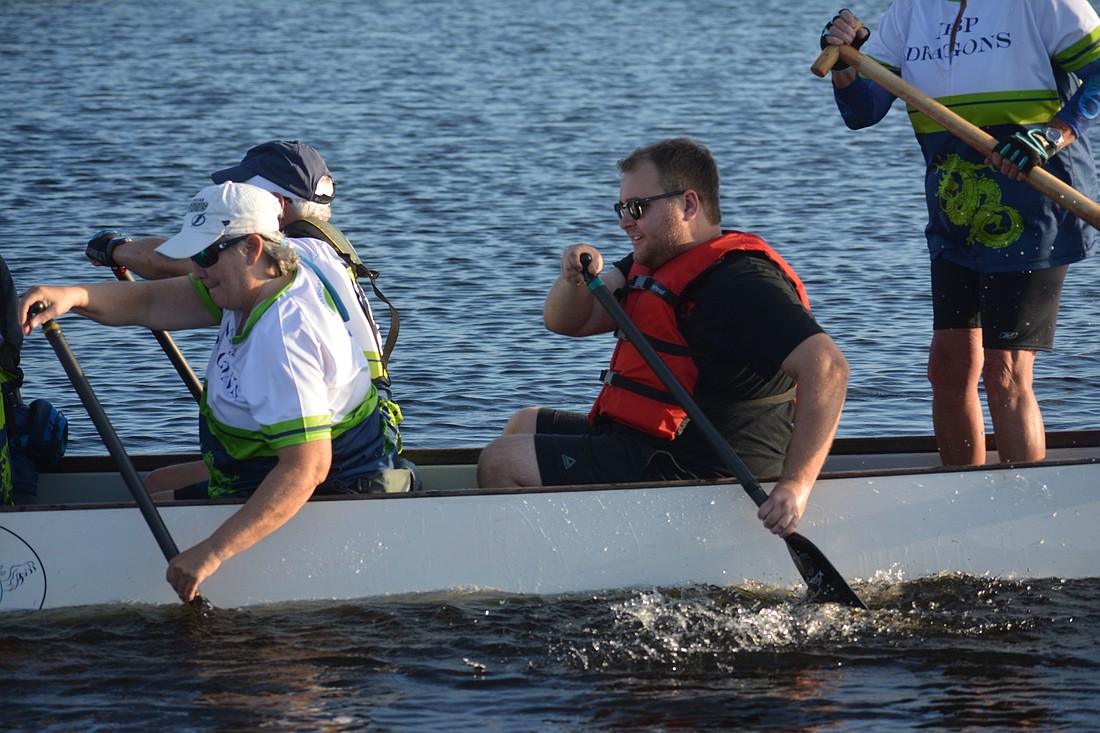- December 5, 2025
-
-
Loading

Loading

Dragon boats are no drag.
I learned that firsthand — and days later, my shoulder is still paying the price. It was worth it, though, to learn what makes this sport special.
My journey began on Sept. 24 at Nathan Benderson Park. I met Annely Thorstad, the coach of the NBP Dragons competitive and recreational teams, by the water, where she informed me I would be rowing with the competitive team.
Gulp.
I had not rowed a boat since my days in Boy Scouts, and those days are long gone. I couldn’t let my trepidation show, though, so I pressed onward.
The first thing the team did was stretch. This, I could do. Arm circles, hamstring stretches, abdominal bends — this was basic stuff, but it got the job done. Then the team took a brief walk, from the docks to the front parking lot and back, to ease into things. I put on my lifejacket and grabbed my oar. You only use one oar per person in dragon boat, making it the equivalent of “sweep” style in rowing.
Then Thorstad, after seeing my nervous face, taught me the basics. You hold the oar with both hands, placing one hand’s pinky finger in the gap between the head and the shaft and holding the rear end of the oar firmly with the other hand. Both hands should be held over the water at all times. You use your body to row more than your hands, reaching as far forward as you can, then driving the oar into the water with you top hand, deep enough that your pinky gets wet. Once it does, move your body back to an upright position and the oar will naturally move as well, propelling the boat forward.
“You’ll be fine,” Thorstad said.
In retrospect, that was probably out of pity, but it calmed my nerves. It all sounded so simple, after all. I climbed into the dragon boat — which did not have a fiery dragon head on it, by the way; those are reserved for festivals and competitive races — and took my place in the 10th and final row. Dragon boats can fit 20 rowers, sitting two to a row, but we only had 19 and I had a row to myself.
Then I had to put what I learned into practice. That is when the trouble started. As Thorstad instructed everyone to row, casually, to open water with a blow of her whistle, the crew took off at a pace that did not seem casual to a newbie. I tried to maintain their pace, but I couldn’t. I was flailing around like a fish on a beach. It was getting harder to pull my oar out of the water. I bumped into other rowers’ oars a few times. A few people had told me before I began that rowing at a different pace could cause the boat to tip. I didn’t want that to happen, so I pulled my oar out of the water and watched for a while.
In case you had any doubt, I can tell you firsthand: Dragon boaters are athletes. The sport requires a combination of strength and stamina and sheer will that I previously did not think it did. After a brief in-boat refresher on the basics from Thorstad, I tried again to keep pace. Again, I could not. This time, my arms were the issue. I was not used to using them in this fashion, and it was not long before I had to pull my oar up once more.
Then the group decided to show off, sprinting for 250 meters. Being on that boat felt like riding a Disney World roller coaster. The Dragons were churning through the water like butter. You could hear the effort being exerted in the grunts and yells of the rowers. It left me stunned.
Eventually, my time with the team had to come to an end, but I will not forget what one rower, Rick Jensen, told me about why he does this.
“To have fun,” Jensen said with a smile. “I just love being on the water.”
He was having the time of his life. I was a broken man. But I had fun, too, despite the pain.
Maybe someday, I'll get on Jensen's level.